Strategic Finance: Analysis of Samsung PLC's Financial Statements
VerifiedAdded on 2021/02/19
|13
|2408
|302
Report
AI Summary
This report, prepared for a business chamber committee, analyzes Samsung PLC's financial performance, strategic decision-making, and financial statements. It begins with an introduction to strategic management and its importance in evaluating market data and profitability. Task 1 focuses on financial data's role in strategic decisions, assessing financial information, and evaluating risks and capital expenditure appraisal methods. Task 2 interprets Samsung PLC's balance sheet and profit and loss statements, comparing key financial data across two years using ratio analysis to assess liquidity, solvency, and profitability. Task 3 delves into the impact of creative accounting techniques, the limitations of ratio analysis, and the significance of cash flow management. Finally, Task 4 applies capital expenditure appraisal techniques to evaluate investment decisions. The report concludes with a summary of findings and a list of references.
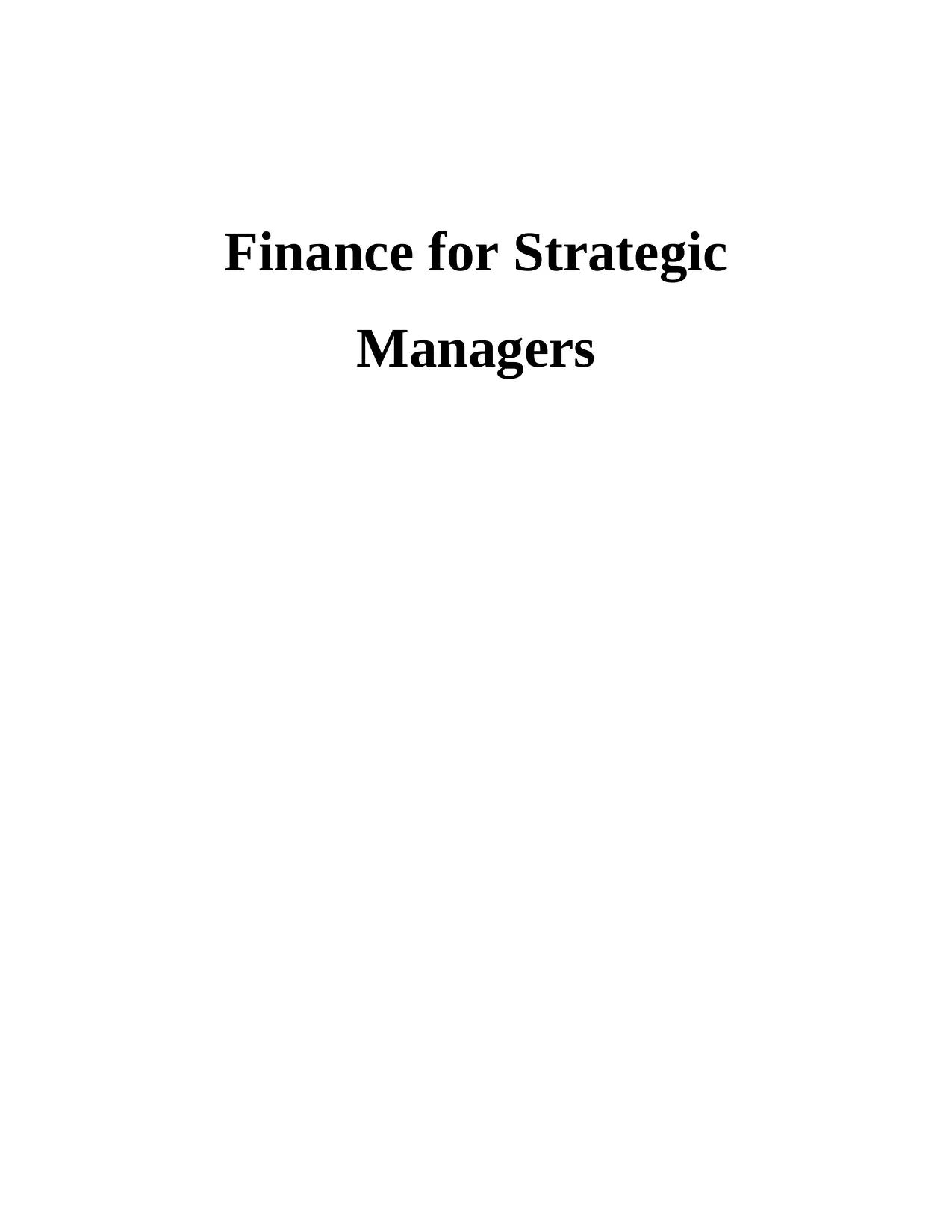
Finance for Strategic
Managers
Managers
Paraphrase This Document
Need a fresh take? Get an instant paraphrase of this document with our AI Paraphraser
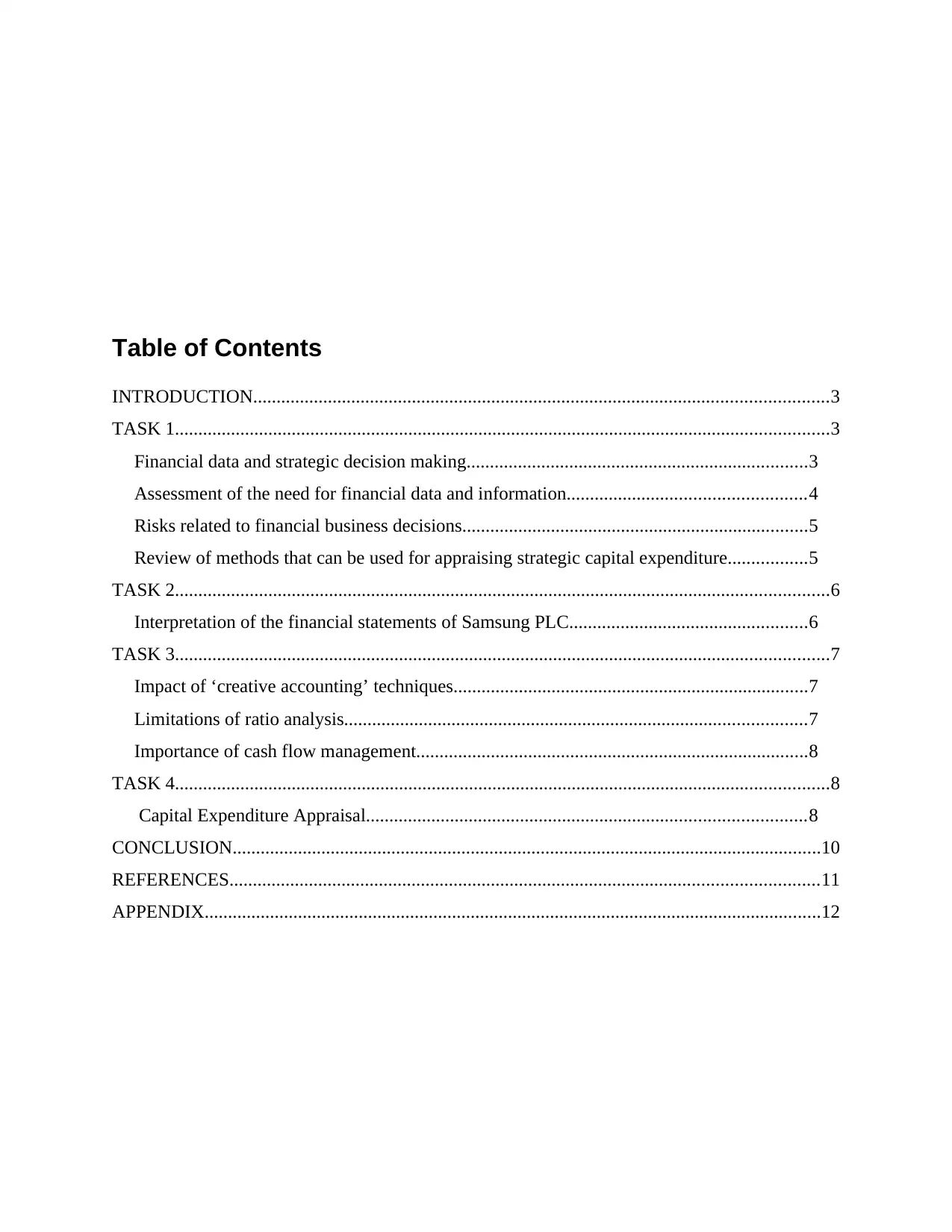
Table of Contents
INTRODUCTION...........................................................................................................................3
TASK 1............................................................................................................................................3
Financial data and strategic decision making.........................................................................3
Assessment of the need for financial data and information...................................................4
Risks related to financial business decisions..........................................................................5
Review of methods that can be used for appraising strategic capital expenditure.................5
TASK 2............................................................................................................................................6
Interpretation of the financial statements of Samsung PLC...................................................6
TASK 3............................................................................................................................................7
Impact of ‘creative accounting’ techniques............................................................................7
Limitations of ratio analysis...................................................................................................7
Importance of cash flow management....................................................................................8
TASK 4............................................................................................................................................8
Capital Expenditure Appraisal..............................................................................................8
CONCLUSION..............................................................................................................................10
REFERENCES..............................................................................................................................11
APPENDIX....................................................................................................................................12
INTRODUCTION...........................................................................................................................3
TASK 1............................................................................................................................................3
Financial data and strategic decision making.........................................................................3
Assessment of the need for financial data and information...................................................4
Risks related to financial business decisions..........................................................................5
Review of methods that can be used for appraising strategic capital expenditure.................5
TASK 2............................................................................................................................................6
Interpretation of the financial statements of Samsung PLC...................................................6
TASK 3............................................................................................................................................7
Impact of ‘creative accounting’ techniques............................................................................7
Limitations of ratio analysis...................................................................................................7
Importance of cash flow management....................................................................................8
TASK 4............................................................................................................................................8
Capital Expenditure Appraisal..............................................................................................8
CONCLUSION..............................................................................................................................10
REFERENCES..............................................................................................................................11
APPENDIX....................................................................................................................................12
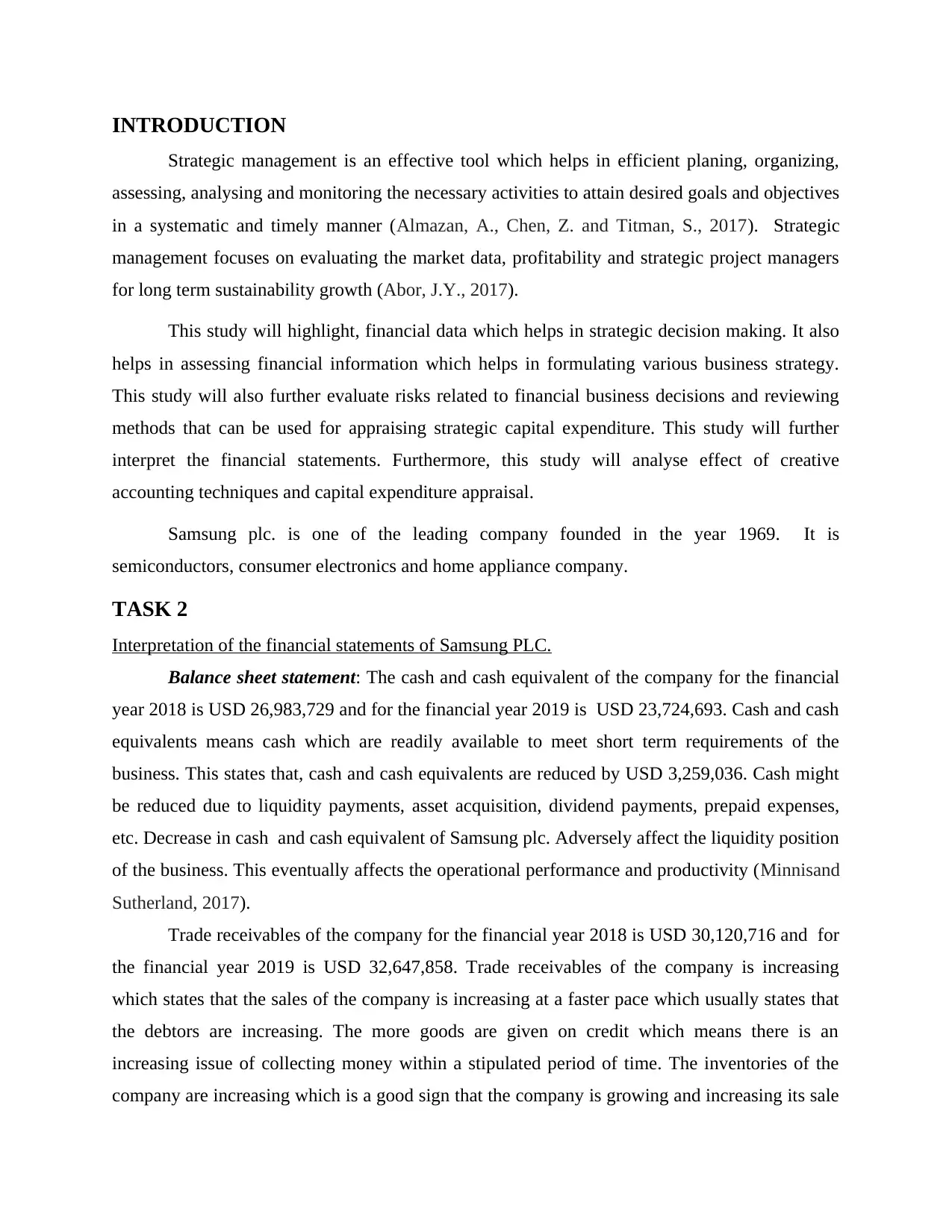
INTRODUCTION
Strategic management is an effective tool which helps in efficient planing, organizing,
assessing, analysing and monitoring the necessary activities to attain desired goals and objectives
in a systematic and timely manner (Almazan, A., Chen, Z. and Titman, S., 2017). Strategic
management focuses on evaluating the market data, profitability and strategic project managers
for long term sustainability growth (Abor, J.Y., 2017).
This study will highlight, financial data which helps in strategic decision making. It also
helps in assessing financial information which helps in formulating various business strategy.
This study will also further evaluate risks related to financial business decisions and reviewing
methods that can be used for appraising strategic capital expenditure. This study will further
interpret the financial statements. Furthermore, this study will analyse effect of creative
accounting techniques and capital expenditure appraisal.
Samsung plc. is one of the leading company founded in the year 1969. It is
semiconductors, consumer electronics and home appliance company.
TASK 2
Interpretation of the financial statements of Samsung PLC.
Balance sheet statement: The cash and cash equivalent of the company for the financial
year 2018 is USD 26,983,729 and for the financial year 2019 is USD 23,724,693. Cash and cash
equivalents means cash which are readily available to meet short term requirements of the
business. This states that, cash and cash equivalents are reduced by USD 3,259,036. Cash might
be reduced due to liquidity payments, asset acquisition, dividend payments, prepaid expenses,
etc. Decrease in cash and cash equivalent of Samsung plc. Adversely affect the liquidity position
of the business. This eventually affects the operational performance and productivity (Minnisand
Sutherland, 2017).
Trade receivables of the company for the financial year 2018 is USD 30,120,716 and for
the financial year 2019 is USD 32,647,858. Trade receivables of the company is increasing
which states that the sales of the company is increasing at a faster pace which usually states that
the debtors are increasing. The more goods are given on credit which means there is an
increasing issue of collecting money within a stipulated period of time. The inventories of the
company are increasing which is a good sign that the company is growing and increasing its sale
Strategic management is an effective tool which helps in efficient planing, organizing,
assessing, analysing and monitoring the necessary activities to attain desired goals and objectives
in a systematic and timely manner (Almazan, A., Chen, Z. and Titman, S., 2017). Strategic
management focuses on evaluating the market data, profitability and strategic project managers
for long term sustainability growth (Abor, J.Y., 2017).
This study will highlight, financial data which helps in strategic decision making. It also
helps in assessing financial information which helps in formulating various business strategy.
This study will also further evaluate risks related to financial business decisions and reviewing
methods that can be used for appraising strategic capital expenditure. This study will further
interpret the financial statements. Furthermore, this study will analyse effect of creative
accounting techniques and capital expenditure appraisal.
Samsung plc. is one of the leading company founded in the year 1969. It is
semiconductors, consumer electronics and home appliance company.
TASK 2
Interpretation of the financial statements of Samsung PLC.
Balance sheet statement: The cash and cash equivalent of the company for the financial
year 2018 is USD 26,983,729 and for the financial year 2019 is USD 23,724,693. Cash and cash
equivalents means cash which are readily available to meet short term requirements of the
business. This states that, cash and cash equivalents are reduced by USD 3,259,036. Cash might
be reduced due to liquidity payments, asset acquisition, dividend payments, prepaid expenses,
etc. Decrease in cash and cash equivalent of Samsung plc. Adversely affect the liquidity position
of the business. This eventually affects the operational performance and productivity (Minnisand
Sutherland, 2017).
Trade receivables of the company for the financial year 2018 is USD 30,120,716 and for
the financial year 2019 is USD 32,647,858. Trade receivables of the company is increasing
which states that the sales of the company is increasing at a faster pace which usually states that
the debtors are increasing. The more goods are given on credit which means there is an
increasing issue of collecting money within a stipulated period of time. The inventories of the
company are increasing which is a good sign that the company is growing and increasing its sale
⊘ This is a preview!⊘
Do you want full access?
Subscribe today to unlock all pages.

Trusted by 1+ million students worldwide
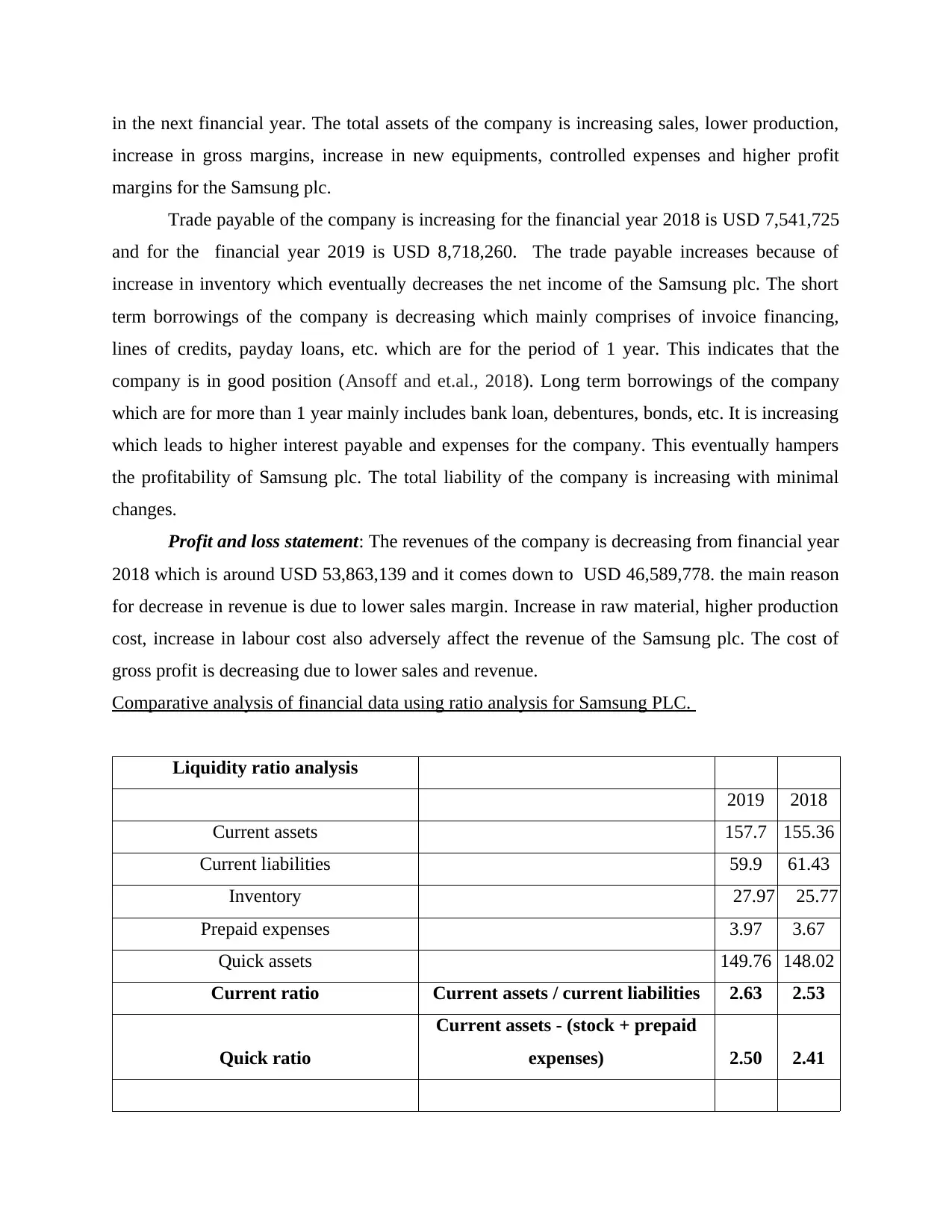
in the next financial year. The total assets of the company is increasing sales, lower production,
increase in gross margins, increase in new equipments, controlled expenses and higher profit
margins for the Samsung plc.
Trade payable of the company is increasing for the financial year 2018 is USD 7,541,725
and for the financial year 2019 is USD 8,718,260. The trade payable increases because of
increase in inventory which eventually decreases the net income of the Samsung plc. The short
term borrowings of the company is decreasing which mainly comprises of invoice financing,
lines of credits, payday loans, etc. which are for the period of 1 year. This indicates that the
company is in good position (Ansoff and et.al., 2018). Long term borrowings of the company
which are for more than 1 year mainly includes bank loan, debentures, bonds, etc. It is increasing
which leads to higher interest payable and expenses for the company. This eventually hampers
the profitability of Samsung plc. The total liability of the company is increasing with minimal
changes.
Profit and loss statement: The revenues of the company is decreasing from financial year
2018 which is around USD 53,863,139 and it comes down to USD 46,589,778. the main reason
for decrease in revenue is due to lower sales margin. Increase in raw material, higher production
cost, increase in labour cost also adversely affect the revenue of the Samsung plc. The cost of
gross profit is decreasing due to lower sales and revenue.
Comparative analysis of financial data using ratio analysis for Samsung PLC.
Liquidity ratio analysis
2019 2018
Current assets 157.7 155.36
Current liabilities 59.9 61.43
Inventory 27.97 25.77
Prepaid expenses 3.97 3.67
Quick assets 149.76 148.02
Current ratio Current assets / current liabilities 2.63 2.53
Quick ratio
Current assets - (stock + prepaid
expenses) 2.50 2.41
increase in gross margins, increase in new equipments, controlled expenses and higher profit
margins for the Samsung plc.
Trade payable of the company is increasing for the financial year 2018 is USD 7,541,725
and for the financial year 2019 is USD 8,718,260. The trade payable increases because of
increase in inventory which eventually decreases the net income of the Samsung plc. The short
term borrowings of the company is decreasing which mainly comprises of invoice financing,
lines of credits, payday loans, etc. which are for the period of 1 year. This indicates that the
company is in good position (Ansoff and et.al., 2018). Long term borrowings of the company
which are for more than 1 year mainly includes bank loan, debentures, bonds, etc. It is increasing
which leads to higher interest payable and expenses for the company. This eventually hampers
the profitability of Samsung plc. The total liability of the company is increasing with minimal
changes.
Profit and loss statement: The revenues of the company is decreasing from financial year
2018 which is around USD 53,863,139 and it comes down to USD 46,589,778. the main reason
for decrease in revenue is due to lower sales margin. Increase in raw material, higher production
cost, increase in labour cost also adversely affect the revenue of the Samsung plc. The cost of
gross profit is decreasing due to lower sales and revenue.
Comparative analysis of financial data using ratio analysis for Samsung PLC.
Liquidity ratio analysis
2019 2018
Current assets 157.7 155.36
Current liabilities 59.9 61.43
Inventory 27.97 25.77
Prepaid expenses 3.97 3.67
Quick assets 149.76 148.02
Current ratio Current assets / current liabilities 2.63 2.53
Quick ratio
Current assets - (stock + prepaid
expenses) 2.50 2.41
Paraphrase This Document
Need a fresh take? Get an instant paraphrase of this document with our AI Paraphraser
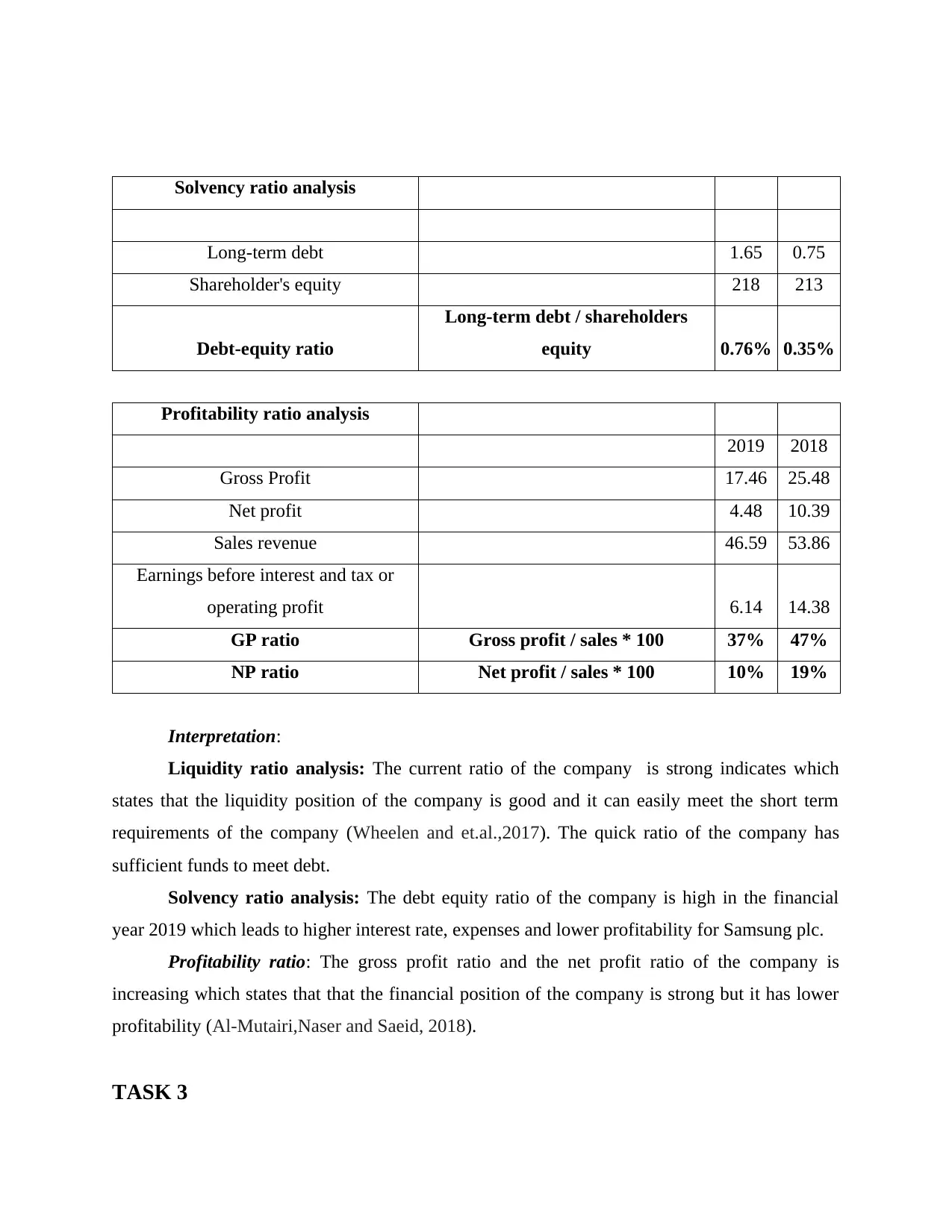
Solvency ratio analysis
Long-term debt 1.65 0.75
Shareholder's equity 218 213
Debt-equity ratio
Long-term debt / shareholders
equity 0.76% 0.35%
Profitability ratio analysis
2019 2018
Gross Profit 17.46 25.48
Net profit 4.48 10.39
Sales revenue 46.59 53.86
Earnings before interest and tax or
operating profit 6.14 14.38
GP ratio Gross profit / sales * 100 37% 47%
NP ratio Net profit / sales * 100 10% 19%
Interpretation:
Liquidity ratio analysis: The current ratio of the company is strong indicates which
states that the liquidity position of the company is good and it can easily meet the short term
requirements of the company (Wheelen and et.al.,2017). The quick ratio of the company has
sufficient funds to meet debt.
Solvency ratio analysis: The debt equity ratio of the company is high in the financial
year 2019 which leads to higher interest rate, expenses and lower profitability for Samsung plc.
Profitability ratio: The gross profit ratio and the net profit ratio of the company is
increasing which states that that the financial position of the company is strong but it has lower
profitability (Al-Mutairi,Naser and Saeid, 2018).
TASK 3
Long-term debt 1.65 0.75
Shareholder's equity 218 213
Debt-equity ratio
Long-term debt / shareholders
equity 0.76% 0.35%
Profitability ratio analysis
2019 2018
Gross Profit 17.46 25.48
Net profit 4.48 10.39
Sales revenue 46.59 53.86
Earnings before interest and tax or
operating profit 6.14 14.38
GP ratio Gross profit / sales * 100 37% 47%
NP ratio Net profit / sales * 100 10% 19%
Interpretation:
Liquidity ratio analysis: The current ratio of the company is strong indicates which
states that the liquidity position of the company is good and it can easily meet the short term
requirements of the company (Wheelen and et.al.,2017). The quick ratio of the company has
sufficient funds to meet debt.
Solvency ratio analysis: The debt equity ratio of the company is high in the financial
year 2019 which leads to higher interest rate, expenses and lower profitability for Samsung plc.
Profitability ratio: The gross profit ratio and the net profit ratio of the company is
increasing which states that that the financial position of the company is strong but it has lower
profitability (Al-Mutairi,Naser and Saeid, 2018).
TASK 3
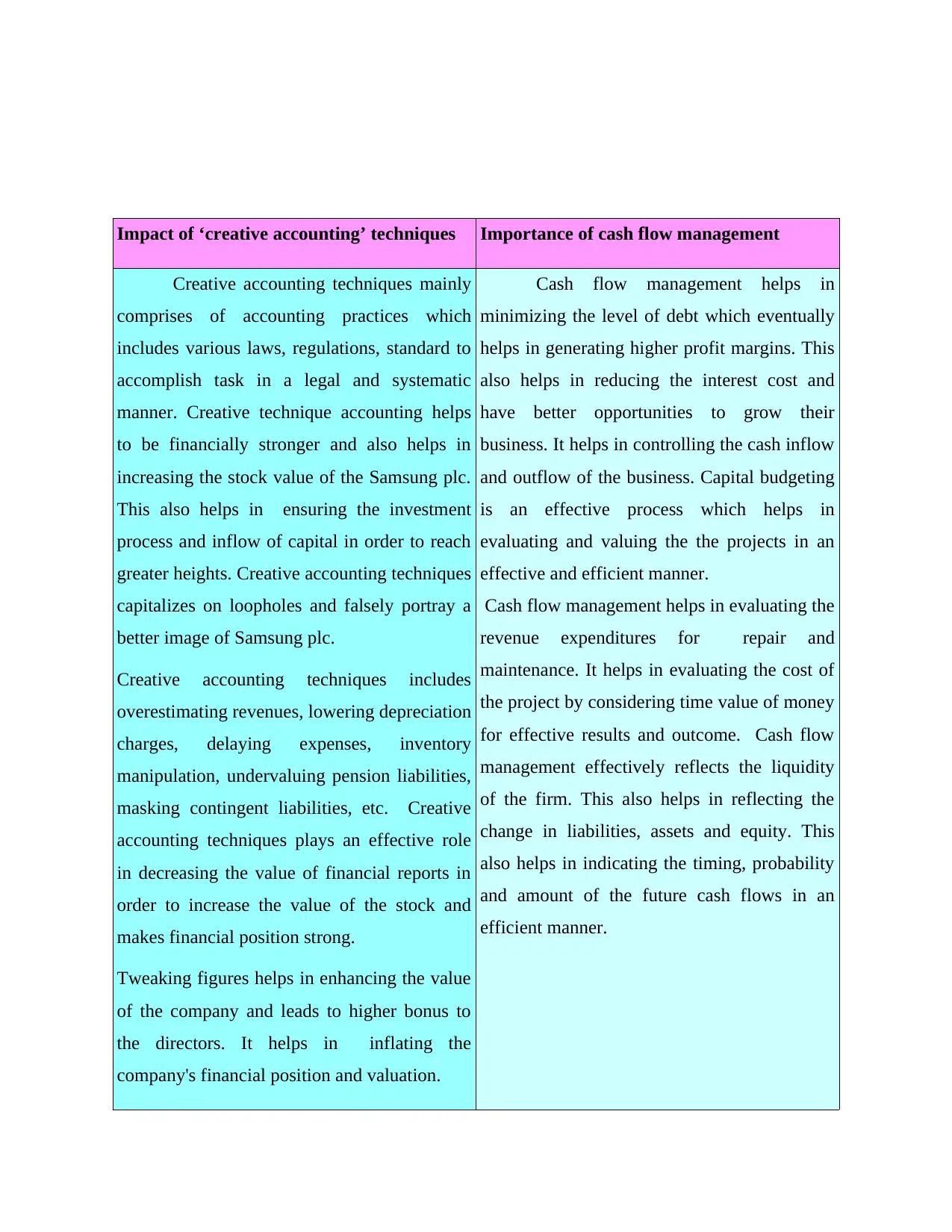
Impact of ‘creative accounting’ techniques Importance of cash flow management
Creative accounting techniques mainly
comprises of accounting practices which
includes various laws, regulations, standard to
accomplish task in a legal and systematic
manner. Creative technique accounting helps
to be financially stronger and also helps in
increasing the stock value of the Samsung plc.
This also helps in ensuring the investment
process and inflow of capital in order to reach
greater heights. Creative accounting techniques
capitalizes on loopholes and falsely portray a
better image of Samsung plc.
Creative accounting techniques includes
overestimating revenues, lowering depreciation
charges, delaying expenses, inventory
manipulation, undervaluing pension liabilities,
masking contingent liabilities, etc. Creative
accounting techniques plays an effective role
in decreasing the value of financial reports in
order to increase the value of the stock and
makes financial position strong.
Tweaking figures helps in enhancing the value
of the company and leads to higher bonus to
the directors. It helps in inflating the
company's financial position and valuation.
Cash flow management helps in
minimizing the level of debt which eventually
helps in generating higher profit margins. This
also helps in reducing the interest cost and
have better opportunities to grow their
business. It helps in controlling the cash inflow
and outflow of the business. Capital budgeting
is an effective process which helps in
evaluating and valuing the the projects in an
effective and efficient manner.
Cash flow management helps in evaluating the
revenue expenditures for repair and
maintenance. It helps in evaluating the cost of
the project by considering time value of money
for effective results and outcome. Cash flow
management effectively reflects the liquidity
of the firm. This also helps in reflecting the
change in liabilities, assets and equity. This
also helps in indicating the timing, probability
and amount of the future cash flows in an
efficient manner.
Creative accounting techniques mainly
comprises of accounting practices which
includes various laws, regulations, standard to
accomplish task in a legal and systematic
manner. Creative technique accounting helps
to be financially stronger and also helps in
increasing the stock value of the Samsung plc.
This also helps in ensuring the investment
process and inflow of capital in order to reach
greater heights. Creative accounting techniques
capitalizes on loopholes and falsely portray a
better image of Samsung plc.
Creative accounting techniques includes
overestimating revenues, lowering depreciation
charges, delaying expenses, inventory
manipulation, undervaluing pension liabilities,
masking contingent liabilities, etc. Creative
accounting techniques plays an effective role
in decreasing the value of financial reports in
order to increase the value of the stock and
makes financial position strong.
Tweaking figures helps in enhancing the value
of the company and leads to higher bonus to
the directors. It helps in inflating the
company's financial position and valuation.
Cash flow management helps in
minimizing the level of debt which eventually
helps in generating higher profit margins. This
also helps in reducing the interest cost and
have better opportunities to grow their
business. It helps in controlling the cash inflow
and outflow of the business. Capital budgeting
is an effective process which helps in
evaluating and valuing the the projects in an
effective and efficient manner.
Cash flow management helps in evaluating the
revenue expenditures for repair and
maintenance. It helps in evaluating the cost of
the project by considering time value of money
for effective results and outcome. Cash flow
management effectively reflects the liquidity
of the firm. This also helps in reflecting the
change in liabilities, assets and equity. This
also helps in indicating the timing, probability
and amount of the future cash flows in an
efficient manner.
⊘ This is a preview!⊘
Do you want full access?
Subscribe today to unlock all pages.

Trusted by 1+ million students worldwide

Limitations of ratio analysis.
Ratio analysis is an effective tool which helps in comparing the information derived from
various financial statements to gain in- depth understanding of the cash flows and financial
position of the Samsung plc.
The major limitation of ratio analysis is that the company's financial statement is
improved at the year end which leads to window dressing. Ratio analysis also ignore the
changes ion the price level due to inflation. This in turn does not indicate the accurate financial
position.
Ratio analysis does not helps in resolving the financial problems of the organization.
This is just a means to understand the particular problem,it is not an actual solution. Ratio
analysis ignores the non- monetary aspects and it only takes into consideration quantitative
aspect of the business. Financial statements of the organization reflect historical information
which is not useful in analysing and predicting the future. Ratio analysis does not lay down any
common standards, which makes it difficult for comparison.
TASK 4
Capital Expenditure Appraisal
Capital Budgeting
Old machine new Machine
Capital cost 260000 220000
part exchange allowance 120000
Initial investment 260000
Year
1 90000
2 50000
3 30000
Calculation of direct material and labour
Direct material and labour
Ratio analysis is an effective tool which helps in comparing the information derived from
various financial statements to gain in- depth understanding of the cash flows and financial
position of the Samsung plc.
The major limitation of ratio analysis is that the company's financial statement is
improved at the year end which leads to window dressing. Ratio analysis also ignore the
changes ion the price level due to inflation. This in turn does not indicate the accurate financial
position.
Ratio analysis does not helps in resolving the financial problems of the organization.
This is just a means to understand the particular problem,it is not an actual solution. Ratio
analysis ignores the non- monetary aspects and it only takes into consideration quantitative
aspect of the business. Financial statements of the organization reflect historical information
which is not useful in analysing and predicting the future. Ratio analysis does not lay down any
common standards, which makes it difficult for comparison.
TASK 4
Capital Expenditure Appraisal
Capital Budgeting
Old machine new Machine
Capital cost 260000 220000
part exchange allowance 120000
Initial investment 260000
Year
1 90000
2 50000
3 30000
Calculation of direct material and labour
Direct material and labour
Paraphrase This Document
Need a fresh take? Get an instant paraphrase of this document with our AI Paraphraser

Old machine new Machine
Year 1 2.55 2.4
Year 2 2.68 2.52
Year 3 2.81 2.65
Year 1 2.55 2.4
Year 2 2.68 2.52
Year 3 2.81 2.65

Cash inflows
ye
ar
Sale
s
mater
ial
lab
or
overh
ead
deprecia
tion
repairs
&
mainten
ance
Total
outflo
ws
EBI
T/
EAT
add:
deprecia
tion
Cas
h
inflo
w
1
4500
00
16200
0
540
00 27000 49500 10000
30250
0
1475
00 49500
1970
00
2
2500
00 94500
315
00 15000 27500 10000
17850
0
7150
0 27500
9900
0
3
1500
00 59535
198
45 9000 16500 10000
11488
0
3512
0 16500
1266
20
Computation of NPV
year Cash inflow
PV factor @
15% Discounted cash flows
1 197000 0.87 171390
2 99000 0.756 74844
3 126620 0.658 83316
Total discounted cash
flows 329550
Less: capital cost 100000
NPV 229550
Interpretation: The net present value (NPV) of the machine is 229550. The new machine
will be selected because it will help in higher revenues and cost (Meyer, Neck and Meeks,
2017). The cash inflows of the company is higher which will lead to higher generation of profit
for Samsung plc.
ye
ar
Sale
s
mater
ial
lab
or
overh
ead
deprecia
tion
repairs
&
mainten
ance
Total
outflo
ws
EBI
T/
EAT
add:
deprecia
tion
Cas
h
inflo
w
1
4500
00
16200
0
540
00 27000 49500 10000
30250
0
1475
00 49500
1970
00
2
2500
00 94500
315
00 15000 27500 10000
17850
0
7150
0 27500
9900
0
3
1500
00 59535
198
45 9000 16500 10000
11488
0
3512
0 16500
1266
20
Computation of NPV
year Cash inflow
PV factor @
15% Discounted cash flows
1 197000 0.87 171390
2 99000 0.756 74844
3 126620 0.658 83316
Total discounted cash
flows 329550
Less: capital cost 100000
NPV 229550
Interpretation: The net present value (NPV) of the machine is 229550. The new machine
will be selected because it will help in higher revenues and cost (Meyer, Neck and Meeks,
2017). The cash inflows of the company is higher which will lead to higher generation of profit
for Samsung plc.
⊘ This is a preview!⊘
Do you want full access?
Subscribe today to unlock all pages.

Trusted by 1+ million students worldwide
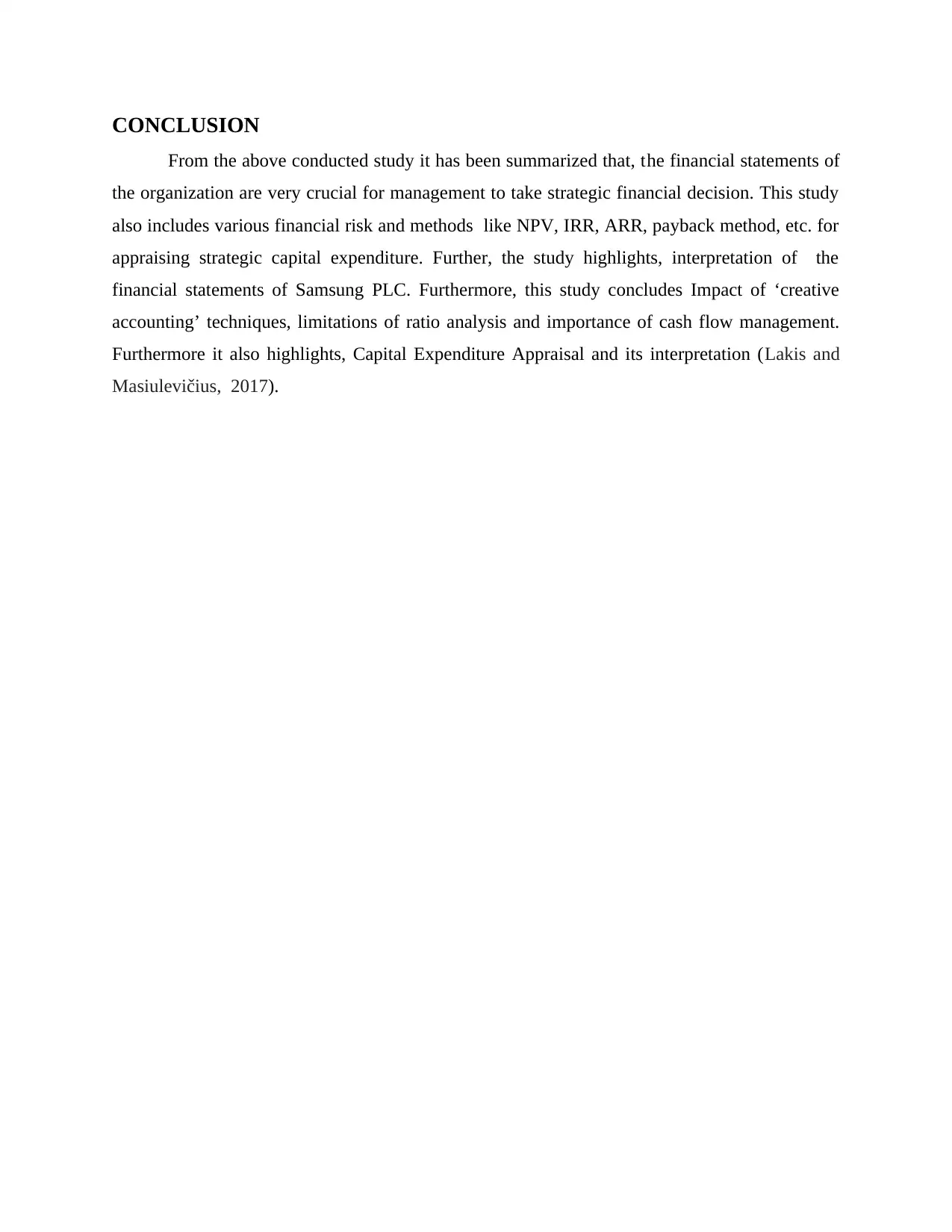
CONCLUSION
From the above conducted study it has been summarized that, the financial statements of
the organization are very crucial for management to take strategic financial decision. This study
also includes various financial risk and methods like NPV, IRR, ARR, payback method, etc. for
appraising strategic capital expenditure. Further, the study highlights, interpretation of the
financial statements of Samsung PLC. Furthermore, this study concludes Impact of ‘creative
accounting’ techniques, limitations of ratio analysis and importance of cash flow management.
Furthermore it also highlights, Capital Expenditure Appraisal and its interpretation (Lakis and
Masiulevičius, 2017).
From the above conducted study it has been summarized that, the financial statements of
the organization are very crucial for management to take strategic financial decision. This study
also includes various financial risk and methods like NPV, IRR, ARR, payback method, etc. for
appraising strategic capital expenditure. Further, the study highlights, interpretation of the
financial statements of Samsung PLC. Furthermore, this study concludes Impact of ‘creative
accounting’ techniques, limitations of ratio analysis and importance of cash flow management.
Furthermore it also highlights, Capital Expenditure Appraisal and its interpretation (Lakis and
Masiulevičius, 2017).
Paraphrase This Document
Need a fresh take? Get an instant paraphrase of this document with our AI Paraphraser

REFERENCES
Books and journals
Abor, J.Y., 2017. Evaluating Capital Investment Decisions: Capital Budgeting.
In Entrepreneurial Finance for MSMEs(pp. 293-320). Palgrave Macmillan, Cham.
Al-Mutairi, A., Naser, K. and Saeid, M., 2018. Capital budgeting practices by non-financial
companies listed on Kuwait Stock Exchange (KSE). Cogent Economics & Finance.6(1).
p.1468232.
Almazan, A., Chen, Z. and Titman, S., 2017. Firm Investment and Stakeholder Choices: A Top‐
Down Theory of Capital Budgeting. The Journal of Financ. 72(5). pp.2179-2228.
Ansoff, H.I and et.al., 2018. Implanting strategic management. Springer.
Ginter, P.M., Duncan, W.J. and Swayne, L.E., 2018. The strategic management of health care
organizations. John Wiley & Sons.
Hayward, M and et.al., 2017. Entrepreneurs’ capital budgeting orientations and innovation
outputs: Evidence from Australian biotechnology firms. Long Range Planning. 50(2).
pp.121-133.
Lakis, V. and Masiulevičius, A., 2017. ACCEPTABLE AUDIT MATERIALITY FOR USERS
OF FINANCIAL STATEMENTS. Journal of Management.2(31).
Lasserre, P., 2017. Global strategic management. Macmillan International Higher Education.
Malenko, A., 2018. Optimal dynamic capital budgeting. Available at SSRN 1710884.
Meyer, G.D., Neck, H.M. and Meeks, M.D., 2017. The entrepreneurship‐strategic management
interface. Strategic entrepreneurship: Creating a new mindset. pp.17-44.
Minnis, M. and Sutherland, A., 2017. Financial statements as monitoring mechanisms: Evidence
from small commercial loans. Journal of Accounting Research. 55(1). pp.197-233.
Moutinho, L. and Vargas-Sanchez, A. eds., 2018. Strategic Management in Tourism, CABI
Tourism Texts. Cabi.
Noe, R.A and et.al., 2017. Human resource management: Gaining a competitive advantage.
New York, NY: McGraw-Hill Education.
Wheelen, T.L and et.al.,2017. Strategic management and business policy. (p. 55). Boston:
pearson.
Online
Books and journals
Abor, J.Y., 2017. Evaluating Capital Investment Decisions: Capital Budgeting.
In Entrepreneurial Finance for MSMEs(pp. 293-320). Palgrave Macmillan, Cham.
Al-Mutairi, A., Naser, K. and Saeid, M., 2018. Capital budgeting practices by non-financial
companies listed on Kuwait Stock Exchange (KSE). Cogent Economics & Finance.6(1).
p.1468232.
Almazan, A., Chen, Z. and Titman, S., 2017. Firm Investment and Stakeholder Choices: A Top‐
Down Theory of Capital Budgeting. The Journal of Financ. 72(5). pp.2179-2228.
Ansoff, H.I and et.al., 2018. Implanting strategic management. Springer.
Ginter, P.M., Duncan, W.J. and Swayne, L.E., 2018. The strategic management of health care
organizations. John Wiley & Sons.
Hayward, M and et.al., 2017. Entrepreneurs’ capital budgeting orientations and innovation
outputs: Evidence from Australian biotechnology firms. Long Range Planning. 50(2).
pp.121-133.
Lakis, V. and Masiulevičius, A., 2017. ACCEPTABLE AUDIT MATERIALITY FOR USERS
OF FINANCIAL STATEMENTS. Journal of Management.2(31).
Lasserre, P., 2017. Global strategic management. Macmillan International Higher Education.
Malenko, A., 2018. Optimal dynamic capital budgeting. Available at SSRN 1710884.
Meyer, G.D., Neck, H.M. and Meeks, M.D., 2017. The entrepreneurship‐strategic management
interface. Strategic entrepreneurship: Creating a new mindset. pp.17-44.
Minnis, M. and Sutherland, A., 2017. Financial statements as monitoring mechanisms: Evidence
from small commercial loans. Journal of Accounting Research. 55(1). pp.197-233.
Moutinho, L. and Vargas-Sanchez, A. eds., 2018. Strategic Management in Tourism, CABI
Tourism Texts. Cabi.
Noe, R.A and et.al., 2017. Human resource management: Gaining a competitive advantage.
New York, NY: McGraw-Hill Education.
Wheelen, T.L and et.al.,2017. Strategic management and business policy. (p. 55). Boston:
pearson.
Online

Recognising Risk in Financial Decision Making. 2019. [ONLINE]. Available
through:<https://www.actuaries.asn.au/Library/Events/ACS/2007/5.d_Conv07_Paper_Gor
st_Kapel_Recognising%20risk%20in%20Financial%20Decision%20making.pdf>
through:<https://www.actuaries.asn.au/Library/Events/ACS/2007/5.d_Conv07_Paper_Gor
st_Kapel_Recognising%20risk%20in%20Financial%20Decision%20making.pdf>
⊘ This is a preview!⊘
Do you want full access?
Subscribe today to unlock all pages.

Trusted by 1+ million students worldwide
1 out of 13
Related Documents
Your All-in-One AI-Powered Toolkit for Academic Success.
+13062052269
info@desklib.com
Available 24*7 on WhatsApp / Email
![[object Object]](/_next/static/media/star-bottom.7253800d.svg)
Unlock your academic potential
Copyright © 2020–2025 A2Z Services. All Rights Reserved. Developed and managed by ZUCOL.





